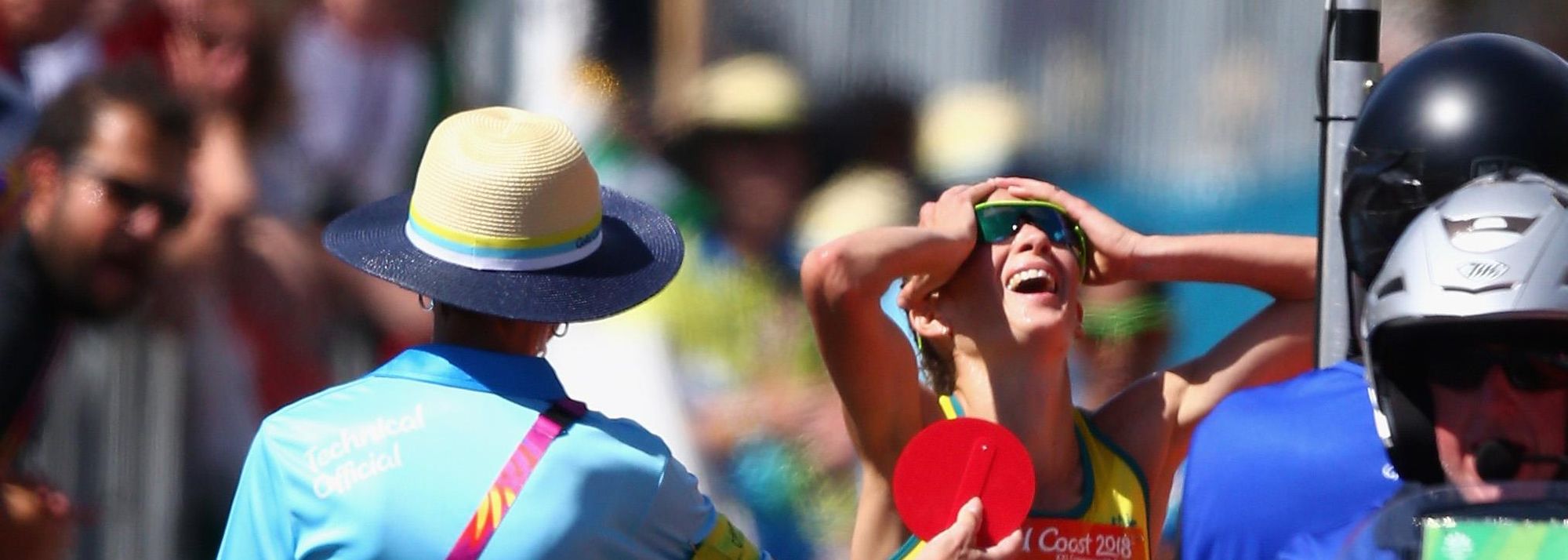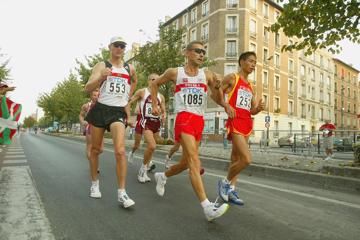Claire Tallent of Australia shown a red card during the 20km race walk at the 2018 Commonwealth Games (© Getty Images)
Ahead of the IAAF World Race Walking Team Championships Taicang 2018, set for 5-6 May, we continue our Way of the walk series as race walking legends Jefferson Perez, Jane Saville and Robert Korzeniowski discuss how the carding system works.
Can you explain how the penalty system works in major championships?
Jane Saville: At major championships, nine judges will be dotted around a 2km course. There will be one chief judge, who has the red paddle, and eight other judges whose job it is to ensure the race walkers abide by the rules. If any of the other eight judges (ie not the chief) have doubts about a race walker’s technique and compliance with the rules they’ll show the athletes a yellow paddle with either a pointed arrow to indicate bent knee or a squiggly line for loss of contact. Yellow paddles do not contribute to a disqualification.
Once awarded a yellow paddle an athlete knows the judge will be taking a close look at technique. If the judge is completely certain the athlete is not complying with the rules they will then award a red card. At major championships, there is a disqualification board indicating if an athlete has a red card and the reason for them. After a third red card the athlete will be disqualified and the chief judge or chief judge’s assistant will show them the red paddle and remove the athlete from the course at the earliest opportunity.
Is it a fair system?
JS: We can improve it and make it less subjective. I believe by using enhanced technology will help the credibility of the sport. We all accept the way the sport is judged but it can be very frustrating. I guess race walking brings together both an artistic side plus the pure first-past-the-post element.
Robert Korzeniowski: I think the term red card is a very negative one, particularly when you compare to its use in other sports. A red card in race walking is mostly about a lack of technique and control. It is not a tackle from behind like in football or a cyclist hanging on to the side of a motorbike to catch the peloton. Yet the sanction is the same; a red card. It is important to stress to younger race walkers and the general public this term (red card), is a negative one.
If a race walker is given one or two red cards in a race how does this impact upon race strategy?
RK: It very much affects race tactics. I recall at the 1997 World Championships (50km Race Walk) both Jesús Ángel Garcia and I had two red cards each. We had an advantage over the rest of the field but neither of us really wanted to attack and go for gold. I think we both tried to hold back to make sure we wouldn’t be disqualified. Yet the strategy can differ and depend on the athlete. Some athletes with two red cards will try and manage that to avoid a third card. Others will take more of a risk.
JS: It depends. You have to remember many athletes have won races with two red cards, it didn’t affect their results. When I have been given red cards in a race I try to improve my concentration levels to work harder on technique. Some people will slow down, but when you slow it can alter your technique and make it worse. So, each race walker has to find a balance. I know when I was under stress during races my shoulders would move up and my stride would shorten. I had to try and relax and work on lengthening my stride.
Jefferson Perez: I was never disqualified in a race walk and the most cards I received was two at the Atlanta Olympics and one of those was for stepping over a hole in the road. I tried not to think about the cards and just focus on the finish line.
What advice would you give a young race walker when they are awarded a red card?
RK: I have only one piece of advice; Look at yourself. Focus only on our own motion. And try not be to be influenced by external factors. The athletes will not re-learn technique in the middle of a race.
Steve Landells for the IAAF





